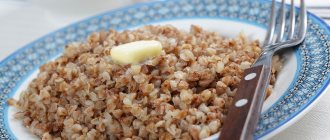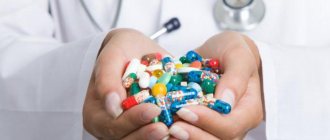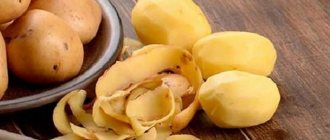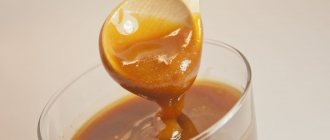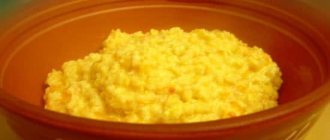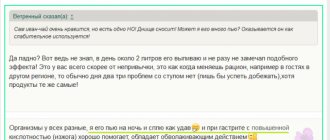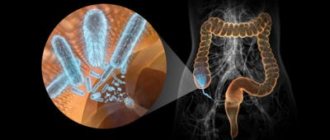Published 04/07/2020 · Comments: · Reading time: 11 min · Views: Post Views: 16,024
A regular cause of digestive disorders is ulcerative lesions of the walls of the stomach, esophagus or intestines. They can lead to the development of intense pain, debilitating heartburn, and sour or bitter belching. To relieve unpleasant symptoms and speed up healing of ulcers, intestinal antiseptics with an astringent effect are used. The drug "De-Nol" is one of the representatives of this group of drugs.
pharmachologic effect
The drug has an astringent effect, due to which a film forms on the surface of the mucous membrane of the stomach and duodenum at the site of the lesion. Thus, the affected areas are protected from the aggressive action of gastric juice, which means that the progression of the process is suspended. The presence of a protective film promotes scarring of ulcerative lesions.
De-Nol is harmful to Helicobacter pylori, which is the main culprit in the formation of ulcers on the gastrointestinal mucosa. Not a single strain of this pathogenic bacterium is resistant to this drug.
In addition, taking the drug has a beneficial effect on the digestion process in the stomach due to the fact that it improves microcirculation in the mucous membrane of its antrum.
How De-Nol helps with pancreatitis and other gastrointestinal diseases
The active components of De-Nol, penetrating the thickness of the gastric mucosa and interacting with its acidic contents, begin to bind protein complexes and then enter into a series of biochemical reactions. Bismuth settles on the gastric mucosa, forming a barrier film exclusively on the affected tissues, which prevents functional dyspepsia (when the stomach is unable to digest food). The drug prevents excess release of bile acids. This property allows De-Nol to be used for cholecystitis.
Features of the influence of De-Nol on the gastrointestinal tract:
- De-Nol tablets, upon penetration into stomach cells, stimulate the synthesis of PGE2. Prostaglandin E2 is responsible for the production of mucin. This is a mucous secretion that protects the walls of the stomach from damage.
- The release of bicarbonates is activated, which “quenches” stomach acid. With an excess of hydrochloric acid in gastric juice, the risk of developing erosive gastritis increases.
- Bismuth improves blood circulation in the walls of the stomach, pancreas and liver. These properties allow the drug to be used not only for gastric pathologies, but also for inflammation of the pancreas, hepatitis and other ailments.
- De-Nol normalizes cellular metabolism, which also significantly increases the protective and restorative properties of the gastric mucosa.
- Inhibits cells that synthesize hydrochloric acid.
De-Nol is not absorbed into the systemic circulation. Therefore, the drug does not have a systemic effect on the body and does not burden the kidneys.
The effectiveness of De-Nol for pancreatitis is based on the suppression of enzyme synthesis. This phenomenon promotes “unloading” and rapid recovery of the organ.
Although high acidity is a factor contributing to the development of ulcers, at the same time, if it is excessively decontaminated, the resistance of the digestive tract to infections and disorders decreases.
What do De-Nol tablets help with?
Taking this medicine is indicated for:
- Acute and chronic gastritis and gastroduodenitis;
- Exacerbations of gastric and duodenal ulcers;
- Gastropathy that developed as a result of taking NSAIDs or alcohol;
- Functional dyspepsia.
In addition, a gastroenterologist may prescribe De-Nol for pancreatitis. In this case, the drug helps eliminate intestinal dyskinesia, which often accompanies a chronic inflammatory process in the pancreas.
Stool color during treatment with De-Nol
Treatment with De-Nol turns the stool not only black. During therapy, stool may acquire greenish and dark brown shades. This is explained by the individual characteristics and reactions of the body. Equally important is the nature of the diet (some foods change the color of stool), and other medications that are taken at the same time and also affect the color of stool.
De-Nol is a modern gastroprotective drug that effectively cures ulcers and erosions in the stomach and duodenal bulb. Such minor phenomena as a change in stool color compared to the effectiveness of the medicine are not a reason to discontinue it.
Composition of the drug
The only active ingredient in De-Nol is bismuth in the form of subcitrate. This is the main component that creates a colloidal film at the site of localization of mucosal defects. Each tablet contains 304.6 mg of active substance. In terms of bismuth oxide, this corresponds to 120 mg.
The preparation contains a number of additional substances (corn starch, magnesium stearate and others).
How to drink De-Nol
Adults and children over 12 years of age can take 4 tablets per day. They can be divided into 4 or 2 doses.
It is recommended to take the tablets half an hour before meals with water.
The drug is also used for diseases of the stomach and duodenum that are associated with the bacterium Helicobacter pylori. De-Nol is included in schemes for destroying this microbe along with antibacterial drugs.
According to experts, this drug increases the effectiveness of the Helicobacter pylori eradication (destruction) regimen. In addition, taking De-Nol is not accompanied by the risk of developing unnecessary adverse reactions, which is also important when using such a serious treatment regimen.
"De-Nol" - instructions for use
The drug has an antiulcer effect due to the physicochemical properties of the components. The main substance is an organic compound of bismuth, which decomposes into insoluble components in the acidic gastric environment.
The active substance forms an insoluble film on bleeding ulcers and erosive lesions, combining with blood proteins. That is why “De-Nol” is effective in the acute stage, but it does not have such a pronounced effect on scarring and healed ulcers.
Such a protective film, as it were, covers up damage from aggressive environmental influences, allowing them to heal peacefully. Additionally, the process is facilitated by the antiseptic and anti-inflammatory effect of the drug. The components of “De-Nol” also stimulate the formation of mucus, the production of bicarbonate and other substances natural to the body, which increase the immunity of the mucous membrane of the digestive system to the effects of hydrochloric acid, digestive enzymes and bile.
In addition, “De-Nol” has a bactericidal effect on Helicobacter pylori. It is this unpleasant microorganism that in most cases is the culprit of peptic ulcer disease. Doctors usually prescribe not one, but a complex of drugs that enhance the effect of each other.
The medicine “De-Nol” is produced in the form of tablets with a dose of 120 mg, 32, 56 or 112 pieces per package. The tablets are film-coated, which does not imply their division into parts.
This is what the De Nol tablet looks like:
The price for De-Nol in pharmacies (Central region) is about 1000 rubles for a large package, and about 650 for a small one. In most pharmacies you can ask to purchase several records from a large pack. Online pharmacies can also boast lower prices, but you will have to buy the entire package.
Indications for use
- acute phase of gastric ulcer;
- functional digestive disorders not caused by organic gastrointestinal diseases;
- exacerbation of chronic gastritis;
- irritable bowel syndrome, predominantly with diarrhea.
How to take De-Nol?
For adults and children over 12 years of age there are two equal schemes:
1. 1 tablet 120 mg 4 times a day half an hour before meals and at night.
2. 2 tablets twice a day, half an hour before meals.
Most often, doctors prescribe the second option, since most patients simply forget to take the medicine 4 times a day. The second scheme is thus more compliant.
Taking medication 30 minutes before meals is not convenient for everyone. Most people will first sit down to eat, and then slap themselves on the forehead: “I forgot to take my pills!” Establishing a clear diet regimen can help with this. By the way, adherence to diet and nutrition is the main part of the success of treating gastrointestinal ulcers. Plus, if you eat by the hour, it’s easier to remember to take your pills.
"De-Nol" for children
The drug is contraindicated for children under 4 years of age.
Dosage regimens for children of different ages:
1. From 8 to 12 years - 1 tablet 2 times a day, half an hour before meals.
2. From 4 to 8 years, the scheme is a little more complicated - you need to calculate the dose by weight. The dosage is used at the rate of 8 mg per 1 kg of child weight per day. Do not forget that it is impossible to divide De-Nol tablets, so in the end they use the most approximate dose - 1 or 2 tablets per day.
Example.
A 7-year-old child weighs 26 kg. We calculate the dosage: 8 mg ˣ 26 = 208 mg.
1 De-Nol tablet contains 120 mg. The closest option to calculation is 2 tablets per day.
Important! This is a DAILY dose, not a single dose. In our example, it is advisable to divide it into 2 doses - 1 tablet in the morning and in the evening.
Treatment for young patients must be prescribed by a doctor. Independent experiments in this situation are unacceptable. If your baby systematically complains of pain or a burning sensation in the abdomen, upset stool, or nausea, you need to consult a pediatric gastroenterologist or pediatrician and undergo an examination.
General instructions
Regardless of age, the drug must be taken half an hour before a meal, washed down with a small amount of plain still water (tea, coffee, juices, milk - not!). The course of treatment is 1 - 2 months. After this, a break of at least 8 weeks is required. During this period, you should not take not only “De-Nol” itself or its synonymous substitutes, but also any other medications containing bismuth.
Half an hour before and half an hour after taking bismuth preparations, you should not take other medications, food or drinks. This is especially true for antacids (Almagel, Maalox, Rennie, Phosphalugel, etc.), milk, fruits and juices - these drugs and products can interfere with the normal development of the De-Nol effect. The drug itself may limit the absorption of tetracycline, so their use should be diluted over time, or a different antibiotic should be chosen for treatment.
"De-Nol" - side effects
- possible symptoms of dyspepsia - nausea, vomiting, some increase in bowel movements or, conversely, constipation; usually digestive disorders are minor, mild and short-term;
- skin manifestations of allergies - itching, redness, rash.
The occurrence of side effects should be reported to your doctor; if they increase, the need to change the drug may not be excluded.
When passing through the digestive tract, bismuth sulfide may form from the active substance De-Nol. This compound gives an interesting effect - coloring stool black. Sometimes it can also cause slight darkening of the tongue. Neither one nor the other is scary, has no impact on health and gradually goes away after completion of the course of treatment. It is worth noting that the manufacturer indicates this feature in the instructions in the “Special Instructions” section. Usually the consumer does not finish reading, and then gets scared.
"De-Nol" - contraindications
1. Renal failure in the stage of decompensation.
2. Not for pregnant and lactating women.
3. Children under 4 years old are not allowed.
4. In particular cases of intolerance to one or more components of the drug (including excipients).
With long-term uncontrolled use, especially in doses exceeding the recommended ones, an overdose and poisoning of the body with bismuth may develop. As a result, kidney function may be impaired. Symptoms go away with o, but in severe cases, administration of an antidote (Unithiol) and even dialysis may be required. It is extremely important to follow your doctor’s recommendations, observe the prescribed dosage and duration of the course.
Since the drug is over-the-counter and advertised on TV, consumers often confuse it with one-time remedies for heartburn or abdominal pain. Often “De-Nol” is used incorrectly because “it was once prescribed by a doctor.” As a result, people blame the product for its lack of effectiveness.
Firstly, “De-Nol” accumulates the effect, and it will only be useful if you follow the course of use. Secondly, it is advisable to use this drug precisely in the phase of exacerbation of ulcerative processes, and in combination with other drugs active against Helicobacter pylori (a frequent combination is with Flemoxin, Fromilid, Trichopolum).
Although the drug is on free release, it is not one of those that is reasonable to prescribe to yourself. Usually "De-Nol" is a medical recommendation.
Is De-Nol an antibiotic?
Despite the fact that the drug is capable of destroying Helicobacter pylori, it does not belong to the group of antibacterial agents. Consequently, its use is not associated with the appearance of such unpleasant side symptoms as diarrhea and mucosal candidiasis.
Bacteria cannot develop resistance to De-Nol due to the peculiarities of its pharmacological action. That is why the inclusion of this drug to destroy the pathogenic bacteria helps to completely get rid of the infection.
De-Nol and pancreatitis
Treating pancreatitis with De-Nol without using other medications is ineffective. But taking this medicine is very important in the complex treatment of acute and chronic types of pancreatitis, as well as in the exacerbation phase of the disease.
This is due to the fact that:
- With exacerbation of pancreatitis, which occurs as chronic, the production of pancreatic enzymes increases. They are capable of damaging the mucous membrane of the gastroduodenal tract, provoking the development of gastritis;
- Exacerbation of pancreatitis requires a “starvation” diet in the hospital for up to 5 days: patients do not eat, which creates conditions for damage to the gastric mucosa and duodenum;
- Chronic forms of pancreatitis are often associated with diseases of other parts of the gastrointestinal tract: gastroduodenitis, impaired bile outflow, disorder of motor-evacuation function;
- Pancreatitis can develop due to infection of gland tissue by Helicobacter pylori.
- Treatment of inflammation of the pancreas with De-Nol is carried out in combination with appropriate therapy aimed at eliminating exacerbations of pancreatitis. The drug accelerates the healing process, prevents the production of aggressive digestive juices, reducing their acidity and enzymatic activity, and improves the patency of the ducts of the liver and pancreas.
- These properties are used to prevent the development of gastroduodenitis during the treatment of disorders of the pancreas and to shorten the period of active treatment during exacerbations of chronic forms of the disease. It is especially effective to take De-Nol for pancreatitis if a biliary-dependent type is identified.
Side effects of the drug De-Nol
Taking the drug may be accompanied by the following side effects:
- Nausea and vomiting, frequent bowel movements or constipation.
- On the part of the central nervous system – the development of encephalopathy. This phenomenon is observed only with long-term use of the drug in high doses.
- Skin itching and rashes in case of hypersensitivity to the components of the drug.
The development of adverse symptoms when taking De-Nol is rare. Usually, if all the rules for taking this medicine are followed, patients do not encounter such problems.
Mechanism of action of the drug
Is it possible to drink De-Nol for pancreatitis if there is no gastritis? Many patients are perplexed when these pills are prescribed to them, because they do not suffer from damage to the mucous membranes of the stomach and intestines.
The medication is prescribed during an exacerbation, with the goal of avoiding future deterioration in the gastrointestinal tract. It accelerates the restoration of tissues and mucous membranes, and also increases protective functions and eliminates the inflammatory process.
When taking it, it is important to know the composition and description of the medication:
- active ingredient - bismuth tripotassium citrate;
- has an astringent, antimicrobial, gastrocytoprotective effect;
- tablets are indicated to eliminate gastro- and duodenostasis (such disorders can often be observed in patients with a chronic form of the disease);
- the affected areas are covered with a protective layer, which prevents further erosion of the mucous membranes by digestive juice;
- non-addictive and effective even with regular use;
- the active components included in the product are almost completely excreted in feces and urine.
The drug De-Nol and pancreatitis are directly related to each other. Doctors strongly recommend taking medicine with bismuth, even if you do not have gastritis or ulcerative lesions of the gastrointestinal mucosa.
It is known that the inflammatory process begins due to the penetration of bacteria into the body, and their mobility and reproduction should be stopped immediately, preventing a disorder in the functioning of the gland from developing into an even more serious disease.
Once in the gastric acidic environment, the active substances of the tablets are released, which settle specifically on the inflamed areas, creating a protective layer that does not allow germs to pass through.
Overdose symptoms
An overdose of De-Nol is accompanied by impaired functional activity of the kidneys. These changes are reversible: after discontinuation of the drug, kidney function is completely normalized.
In case of overdose, saline laxatives and enterosorbents are used. Gastric lavage is also recommended.
In rare cases, if the dose is repeatedly exceeded, renal failure may develop. In this case, renal dysfunction can only be compensated for by hemodialysis.
Features of use
Taking De-Nol in excess of the maximum dosage can cause renal dysfunction, including the development of renal failure, so it is very important to follow the treatment regimen prescribed by your doctor. The duration of therapy should not exceed 2 months. Prescribing a repeat course is possible only after a certain period of time without using the medication.
Black-green stool from the drug De-Nol is a common manifestation and does not require any measures. However, it is necessary to distinguish between staining of stool black and darkening of the stool as a result of blood secretions entering it.
Concomitant use with dairy products or medications may reduce the effectiveness of the drug. De-Nol should be taken separately from other medications and products, and the period between doses should be at least an hour.
The drug should not be used in the treatment of pregnant patients. If the medication is prescribed during lactation, it is necessary to interrupt breastfeeding during the course of treatment.
Before starting to use the medication, you must ensure that the patient has no contraindications. Otherwise, therapy may cause severe complications.

